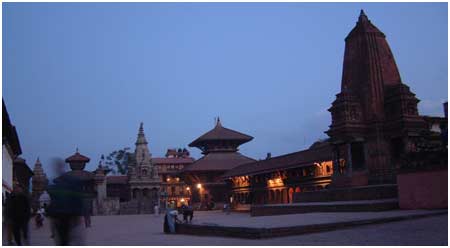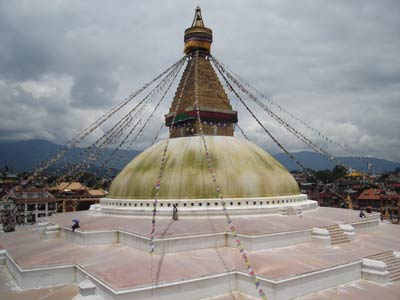


Panorama Historical Tour


- Itinerary
- Cost Info
- Departure
Panorama Historical Tour
Day 01 : Arrival in Kathmandu and transfer to hotel.
Drive to Hotel by private Vehecle.
Day 02 : Kathmandu - Morning sightseeing of Pashupati, Buddha and Kathmandu. Later sightseeing of Patan and Swayambhu.
Kathmandu Durbar Square: Durbar square classic tour takes you to the famous places that have housed kings of different dynasties and temple-scapes representing the finest expamples of Hindu and Buddhist architectures.
Some of the important monuments to be seen here are:
- Taleju temple- tallest of all structures built by king Mahendra Malla in 1549 A.D.
- Jagannath temple- built in the 16th century, known for fascinating erotic figures carving I the wooden struts eaves.
- Kal Bhairav- one of the largest stone idol in Kathmandu representing the terrifying aspects of Shiva.
- Statue of King Pratap Malla in praying gesture to Digu Taleju the royal family deity right across.
- Kumari Ghar- 17th century Kumari temple, an example of the highly developed Nepalese temple craft.
- Kasthamandap- built from the timber of a single tree. The Kathmandu City derives its name from Kasthamandap.
Besides this other fascinating part of this palace complex is the towering Nautale Durbar overlooking the beautiful cityscape and the vast Basantapur square where Prithivi Narayan Shah built mansion to commemorate his victory in 1768 A.D. This building complex is known for the most intricately carved wooden doorways roof struts and massive lattice windows full of mythical figures.
Swayambhunath: One of the world’s most glorious, ancient, enigmatic and the holiest of Buddhist Chaityas, dating back more than 2000 years. Situated on a hillock Swayambhunath, literally “the Self-Created or Existent”, is a mosaic of small stupas and pagoda temple contributed over time by the succession of kings and noblemen. The main structure of the stupa is made of a solid hemisphere of brick and clay, supporting a lofty conical spire and capped by pinnacle of copper gilt. Painted on the four sides on the base of the spire are the “All Seeing Eyes” of Lord Buddha. The main features of Swayambhunath in brief are “The Five Buddhas.”
Pashupatinath: Just a small walk takes you to the temple of Lord Shiva-Pasupatinath with a two tiered golden roof and silver doors. This structure is famous for its superb Newari architecture, situated near the banks of the sacred Bagmati River. Entrance to the temple precinct is permitted to the “Hindus Only”, however visitors can clearly see the temple from the eastern bank of the Bagmati River. Pashupati, literally, “Lord of the Animals” is the patron deity of Nepal and believed to have been unearthed by an obscure herdsman while one of his cattle was showering the earth with milk. Across the sacred river, above the array of decorated monuments, is the “Slasmantak or Mrigasthali Ban (forest)” where legends has it that Lord Siva dwelled in a form of an antelope to evade the hordes of demigods.
Bouddhanth: This colossal and ancient Stupa, one of Nepal’s most unique monuments and said to be the world's biggest, attracts Nepalese pilgrimage of Tibetan stock from as far as Dolpo and Mugu as well as Tibet, Ladhak in India and Bhutan. Baudhanath Stupa, with all seeing eyes of primordial Adi Buddha on all the four sides of the stupa, is said to hold the remains of Kasyapa - the Buddha of the previous time.The Stupa is 100 meters in diameter and was built on an octagonal base. Inset into the base are prayer wheels established by the Lichchivi King Mana Deva in the fifth century. The stupa rises to 36 meters above the base including the spire, “all seeing eyes” and the pinnacle represents the stages of enlightenment, symbol of royalty, compassion, knowing and nirvana. There are many myths about the origins of the stupa. We'll have lunch here after the sightseeing (around 1330hrs).
Day 03 : Kathmandu - Early morning transfer to Dhulikhel to see the beautiful sunrise. Later breakfast at Dhulikhel. Afternoon sightseeing of Bhaktapur.
Bhaktapur : Also known as Bhadgaon, it is situated at an altitude of 1401 m, is a home to medieval art and architecture and was the site for Burtoluchhi’s Little Buddha. The urban city covers an area of 4 sq. miles. Shaped like a conch-shell, Bhaktapur meaning city of Devotees, pottery and weaving are its traditional industries. Bhaktapur, essence of the Newari City, 14 km east of Kathmandu is Nepal’s greatest treasures.
Bhaktapur Durbar Square is a conglomeration of pagoda and shikhara-style temples grouped around a fifty-five window palace of brick and wood. The square is one of the most charming architectural showpieces of the Valley as it highlights the ancient arts of Nepal. The golden effigies of kings perched on the top of stone monoliths, the guardian deities looking out from their sanctuaries, the wood carvings in every place-struts, lintels, uprights, tympanums, gateways and windows-all seem to form a well-orchestrated symphony.
Day 04 : Kathmandu/Pokhara - Surface transfer to Pokhara. Later sightseeing of the lakeside.
Day 05 : Pokhara/Nagarkot - Transfer from Pokhara to Nagarkot for overnight stay.
Day 06 : Kathmandu - Transfer to the airport for a return flight.
Trip Cost :